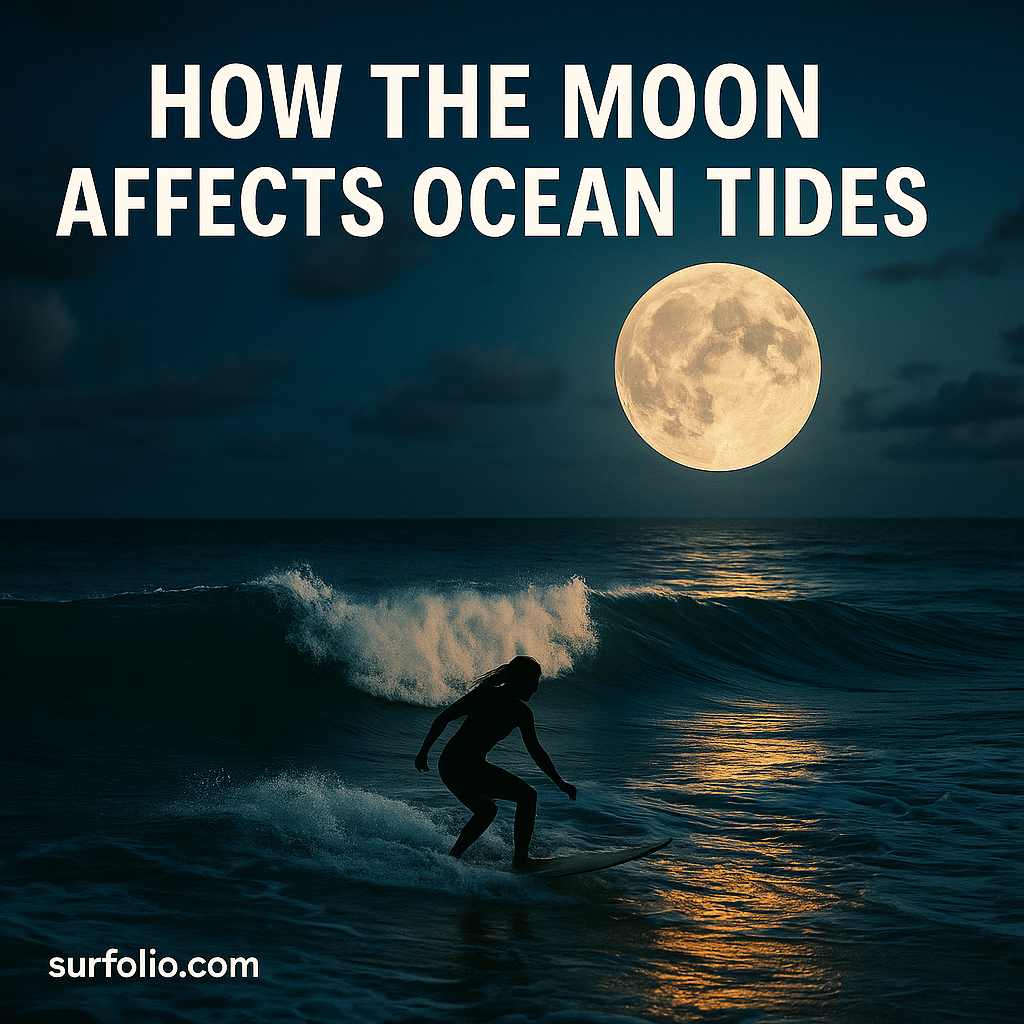
The Moon’s Invisible Pull
Every surfer knows the tides shape their session — but few stop to think about why the water rises and falls each day. The driving force behind these rhythmic changes isn’t just the wind or waves; it’s the gravitational pull of the Moon.
The Moon’s influence on our oceans is one of the most fascinating — and crucial — dynamics in nature. It controls when waves break, how currents move, and even which surf spots fire at specific times.
The Science Behind Tides
Tides are the periodic rise and fall of sea levels caused primarily by the gravitational forces of the Moon and, to a lesser extent, the Sun.
How It Works
- The Moon’s gravity pulls on the water on the side of Earth closest to it, creating a bulge of water — this is a high tide.
- On the opposite side of Earth, another high tide occurs due to centrifugal force created by the Earth-Moon system rotating around a shared center of gravity.
- Between these two bulges, water levels are lower, forming low tides.
As the Earth rotates, different regions pass through these bulges, creating a constant pattern of rising and falling tides every 12 hours and 25 minutes.
The Sun’s Role
While the Moon is the main player, the Sun’s gravity also affects the tides. When the Sun, Moon, and Earth align — during full and new moons — their combined pull creates higher high tides and lower low tides, known as spring tides.
When the Sun and Moon form a right angle relative to Earth — during quarter moons — their gravitational pulls partially cancel each other out, creating neap tides, which have a smaller tidal range.
Summary of Tidal Types
- 🌕 Spring Tides: Strongest tides (during full and new moons)
- 🌓 Neap Tides: Weakest tides (during quarter moons)
The Moon’s Phases and Surf Conditions
Understanding the Moon’s cycle helps surfers predict not just tide levels but also ocean energy. Here’s how each phase can affect your local break:
New Moon 🌑
- The Moon and Sun align on the same side of Earth.
- Strong spring tides occur — more powerful swells and bigger tidal swings.
- Best for reef breaks that need more water movement.
First Quarter 🌓
- The Moon is at a 90° angle from the Sun.
- Smaller tidal range with longer lulls between highs and lows.
- Great for consistency at point breaks or beach breaks.
Full Moon 🌕
- The Moon and Sun are on opposite sides of Earth.
- Another round of strong spring tides — great for deep reef setups.
- Nighttime surfing is sometimes possible under bright illumination.
Last Quarter 🌗
- The opposite of the first quarter, with moderate neap tides.
- Ideal for mellow surf and easier paddle-outs.
Why Tides Matter for Surfers
Tides influence when and how a wave breaks. Understanding them helps you pick the best time to surf your favorite spot.
How Tides Affect Surf Spots
- Beach Breaks: Often best around mid-tide, when water depth shapes the sandbars perfectly.
- Reef Breaks: Usually work best at higher tides, preventing the wave from closing out or hitting shallow coral.
- Point Breaks: Can handle a broader range but change shape depending on tidal height.
Pro Tip: Keep a surf-specific tide chart handy for your local area. Apps like Magicseaweed or Surfline let you check tides alongside swell forecasts.
The Global Connection
Tidal behavior varies worldwide due to coastline shape, ocean depth, and local geography. Some regions experience:
- Semi-diurnal tides: Two highs and two lows per day (most common).
- Diurnal tides: One high and one low per day (e.g., parts of the Gulf of Mexico).
- Mixed tides: A combination of both, with varying highs and lows.
In the Mentawai Islands or Hawaii, understanding tide windows is key to timing perfect sessions.
The Subtle Surf Connection
The Moon doesn’t just affect tides — it influences the rhythm of surfing itself. From the timing of morning glass-offs to the height of reef breaks, surfers intuitively follow the Moon’s pulse.
Some even plan surf trips around lunar cycles, knowing that new and full moons bring more dramatic tidal movement — and sometimes, more energy in the swell.
Final Thoughts
The next time you paddle out, take a moment to glance up at the Moon. Its silent pull has been shaping waves for billions of years — every tide, every session, every perfect ride owes something to its gravity.
Surfing, in many ways, is just learning to move in harmony with the Moon.
